Back to the Vaults 04 — Vandread
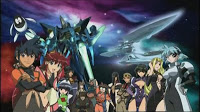 Not too long ago, there was a bit of a buzz in the anime fandom about a scanned page from a Japanese magazine talking about Vandread 2 (not to be confused with Vandread: Second Stage). Apparently this was a planned 3rd series in the franchise but sadly it never got off the ground. However, it did get me to thinking that it has been way too long since I last watched by Vandread DVD’s, so I dusted off the four DVD’s that made up the first series and away I went.
Not too long ago, there was a bit of a buzz in the anime fandom about a scanned page from a Japanese magazine talking about Vandread 2 (not to be confused with Vandread: Second Stage). Apparently this was a planned 3rd series in the franchise but sadly it never got off the ground. However, it did get me to thinking that it has been way too long since I last watched by Vandread DVD’s, so I dusted off the four DVD’s that made up the first series and away I went.
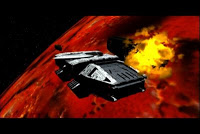 I remember when I was first introduced to Vandread a few years ago. At the time, I had no anime backlog and thus was looking for stuff to watch, whether new on the market or not. Some people suggested to me that I really should give this Vandread anime a watch. I wasn’t looking for a mecha title but after I started renting the series, I quickly discovered that I really enjoyed this fun anime and purchased it and its sequel before having watched the entire anime, something I very rarely do.
I remember when I was first introduced to Vandread a few years ago. At the time, I had no anime backlog and thus was looking for stuff to watch, whether new on the market or not. Some people suggested to me that I really should give this Vandread anime a watch. I wasn’t looking for a mecha title but after I started renting the series, I quickly discovered that I really enjoyed this fun anime and purchased it and its sequel before having watched the entire anime, something I very rarely do.
 For those who don’t know, the premise of the story is that there there are two human colony planets named Mejere and Taraak. Women live on Mejere and Men live on Taraak. The two sides are at war (a literal battle of the sexes) with Taraak having taken the old Earth colony ship Ikazuchi and having constructed a new, larger section to attach to it, turning the Ikazuchi into a battleship. The launch of this new warship is made into a huge even on Taraak, but festivities are spoiled when 3rd-class citizen Hibiki is caught trying to steal one of the new mecha “Vanguard” weapons (having been goaded into doing so) that is marked with the character “hi.”
For those who don’t know, the premise of the story is that there there are two human colony planets named Mejere and Taraak. Women live on Mejere and Men live on Taraak. The two sides are at war (a literal battle of the sexes) with Taraak having taken the old Earth colony ship Ikazuchi and having constructed a new, larger section to attach to it, turning the Ikazuchi into a battleship. The launch of this new warship is made into a huge even on Taraak, but festivities are spoiled when 3rd-class citizen Hibiki is caught trying to steal one of the new mecha “Vanguard” weapons (having been goaded into doing so) that is marked with the character “hi.”
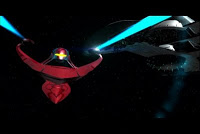 With Hibiki in the brig and guarded by an old NAVI Robot unit, the Ikazuchi comes under attack from a Mejere pirate ship. Since the Ikazuchi is full of trainees, it is clear the battleship will be lost after the original section of the ship is boarded by the female pirates. The general in charge orders that section jettisoned and attempts to destroy it (at which point Hibiki escapes prison with the NAVI Robot). In doing so, the power core of the Ikazuchi, known as the Paksis Pragma, reacts and as the mega warheads explode, rather than destroy the pirate ship and the original part of the Ikazuchi, the ships and their crews are sent to another part of the galaxy, where it will take nearly a year to return home.
With Hibiki in the brig and guarded by an old NAVI Robot unit, the Ikazuchi comes under attack from a Mejere pirate ship. Since the Ikazuchi is full of trainees, it is clear the battleship will be lost after the original section of the ship is boarded by the female pirates. The general in charge orders that section jettisoned and attempts to destroy it (at which point Hibiki escapes prison with the NAVI Robot). In doing so, the power core of the Ikazuchi, known as the Paksis Pragma, reacts and as the mega warheads explode, rather than destroy the pirate ship and the original part of the Ikazuchi, the ships and their crews are sent to another part of the galaxy, where it will take nearly a year to return home.
 The Paksis Pragma causes some unusual effects. It leaks a crystalline substance that causes the Ikazuchi and the pirate ship to merge into a single ship. Not only that, but the pirate ship has some of its configurations changed due to the substance. Three of the pirate Dread fighters that were in the Ikazuchi when the Praksis Pragma “erupted” are also modified, increasing their size so that they no longer fit into the fighter bays. Also, the Vanguard unit that Hibiki had attempted to steal is also made larger and changes somewhat in appearance.
The Paksis Pragma causes some unusual effects. It leaks a crystalline substance that causes the Ikazuchi and the pirate ship to merge into a single ship. Not only that, but the pirate ship has some of its configurations changed due to the substance. Three of the pirate Dread fighters that were in the Ikazuchi when the Praksis Pragma “erupted” are also modified, increasing their size so that they no longer fit into the fighter bays. Also, the Vanguard unit that Hibiki had attempted to steal is also made larger and changes somewhat in appearance.
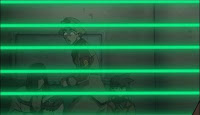 With three men as the female pirates prisoners (Hibiki, navigator Bart, and ship’s doctor Duelo), the pirates not only have to figure out what to do with them, but also what to do about this newly-formed ship. The issue of the men and women being forced to work together comes to a head when an unknown enemy of robotic fighting machines attacks. With the new ship’s weapons non-functional and the crew being unable to move it, the pirate leader (called “Okashira” in the Japanese) has the fast-talking Bart move into the pilot pod, which is how they are able to move. Duelo gives the pirates a much-needed doctor (they only had a young nurse before), so he has a job and for the attack, Hibiki is allowed to use the
With three men as the female pirates prisoners (Hibiki, navigator Bart, and ship’s doctor Duelo), the pirates not only have to figure out what to do with them, but also what to do about this newly-formed ship. The issue of the men and women being forced to work together comes to a head when an unknown enemy of robotic fighting machines attacks. With the new ship’s weapons non-functional and the crew being unable to move it, the pirate leader (called “Okashira” in the Japanese) has the fast-talking Bart move into the pilot pod, which is how they are able to move. Duelo gives the pirates a much-needed doctor (they only had a young nurse before), so he has a job and for the attack, Hibiki is allowed to use the 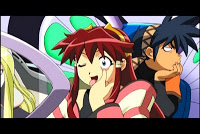 modified Vanguard unit to fight.
modified Vanguard unit to fight.
The battles with this enemy (which gets named the “Harvesters” when the crew learns they’ve been sent from a mysterious planet and are intent on harvesting humans for their various body parts) soon reveal that Hibiki’s Vanguard unit can “combine” with the three modified Dread units to form a new “Vandread” unit of increased power. Each Vandread unit has a different specialty and can be used for different situations.
 The pilots for the three modified Dread units (Dita, the Dread fighter leader Meia, and Jura) form the central female characters to Hibiki’s being the central male character. In addition the female pirate crew consists of characters like the elderly pirate leader Magno Vivan, her vice-captain “BC,” the woman in charge of the Registry (weapons) Gascogne, and the ship’s chief engineer Parfet. The other characters of note are Barnette, who appears to be Jura’s special someone as well as being one of the Dread squad leaders and Ezra, who is part of the bridge crew and who is in the first trimester of pregnancy which is learned after the ship begins the return trip home.
The pilots for the three modified Dread units (Dita, the Dread fighter leader Meia, and Jura) form the central female characters to Hibiki’s being the central male character. In addition the female pirate crew consists of characters like the elderly pirate leader Magno Vivan, her vice-captain “BC,” the woman in charge of the Registry (weapons) Gascogne, and the ship’s chief engineer Parfet. The other characters of note are Barnette, who appears to be Jura’s special someone as well as being one of the Dread squad leaders and Ezra, who is part of the bridge crew and who is in the first trimester of pregnancy which is learned after the ship begins the return trip home.
 Through the course of the series, the ship (which is given the name Nirvana) has the crew not only deal with integration of the former enemies, but also dealing with the constant fights with the Harvesters, learning more about the Harvester mission, and the men and women (primarily through Hibiki and Dita) deal with these strange feelings they have for each other. The series ends with an encounter with a Harvester flagship that ends up with the Nirvana in a race to get home before five other Harvester flagships catch and destroy them.
Through the course of the series, the ship (which is given the name Nirvana) has the crew not only deal with integration of the former enemies, but also dealing with the constant fights with the Harvesters, learning more about the Harvester mission, and the men and women (primarily through Hibiki and Dita) deal with these strange feelings they have for each other. The series ends with an encounter with a Harvester flagship that ends up with the Nirvana in a race to get home before five other Harvester flagships catch and destroy them.
 So, what makes this anime so special? On the surface, it seems little more than a typical shounen mecha sci-fi comedy piece with harem elements to boot. However, the writers end up pulling off some very interesting things. First, their overall story arc involving the Harvesters and their ability to adapt to the strategies of the Nirvana crew give them a Borg-like quality (before they were neutered in Star Trek: Voyager).
So, what makes this anime so special? On the surface, it seems little more than a typical shounen mecha sci-fi comedy piece with harem elements to boot. However, the writers end up pulling off some very interesting things. First, their overall story arc involving the Harvesters and their ability to adapt to the strategies of the Nirvana crew give them a Borg-like quality (before they were neutered in Star Trek: Voyager).
 There’s also a horror element since the Harvestors literally want to harvest humans. On one planet, Anpathos, the Nirvana crew find a colony of humans who’ve been raised to be harvested for their spinal cords. Not only this, but these humans have been conditioned to willingly accept their fate. When Hibiki flees the Nirvana late in the series due to a misunderstanding that causes most of the women to turn on the three male members, he encounters another group of humans who’ve been raised to have their skin harvested. However, these humans are not going to give up without a fight, but in doing so, Hibiki sees people he comes to care for get killed.
There’s also a horror element since the Harvestors literally want to harvest humans. On one planet, Anpathos, the Nirvana crew find a colony of humans who’ve been raised to be harvested for their spinal cords. Not only this, but these humans have been conditioned to willingly accept their fate. When Hibiki flees the Nirvana late in the series due to a misunderstanding that causes most of the women to turn on the three male members, he encounters another group of humans who’ve been raised to have their skin harvested. However, these humans are not going to give up without a fight, but in doing so, Hibiki sees people he comes to care for get killed.
 The second element is the literal battle of the sexes. Having men on one planet and females on another planet for about 100-years with both being seen as “the enemy,” the integration of the men into the female pirate crew turns into an interesting element. The men have heard all sorts of things which aren’t true and the females have heard all sorts of things which aren’t correct. Because females are the overwhelming majority of the crew, it is natural that the writers have them take this integration hardest at times. It felt natural to me that even after the women had accepted the men, a single incident causes the old mistrusts the women had to resurface.
The second element is the literal battle of the sexes. Having men on one planet and females on another planet for about 100-years with both being seen as “the enemy,” the integration of the men into the female pirate crew turns into an interesting element. The men have heard all sorts of things which aren’t true and the females have heard all sorts of things which aren’t correct. Because females are the overwhelming majority of the crew, it is natural that the writers have them take this integration hardest at times. It felt natural to me that even after the women had accepted the men, a single incident causes the old mistrusts the women had to resurface.
 A sub-element of the integrations of the crew comes from some of the women feeling that they don’t need a man to help them do anything and Hibiki’s cocky attitude which annoys some of the women, such as Meia, who sees Hibiki as a threat not only to her leadership, but the moral of her pilots. Having the Nirvana set up so that unless Bart pilots it, it doesn’t move or unless Hibiki’s Vanguard combines with one of the three modified Dread fighters, they are unlikely to win against an improving enemy gives the writers a vehicle to have this distrust overcome that feels right.
A sub-element of the integrations of the crew comes from some of the women feeling that they don’t need a man to help them do anything and Hibiki’s cocky attitude which annoys some of the women, such as Meia, who sees Hibiki as a threat not only to her leadership, but the moral of her pilots. Having the Nirvana set up so that unless Bart pilots it, it doesn’t move or unless Hibiki’s Vanguard combines with one of the three modified Dread fighters, they are unlikely to win against an improving enemy gives the writers a vehicle to have this distrust overcome that feels right.
 With only thirteen episodes, there isn’t a great deal that the writers can do to develope all the characters. However, they give us enough stuff on the important characters so that we understand and like them. Hibiki gets the greatest development among the three males characters. He starts out as a loud-mouth, cocky, cliche-spouting guy. His interactions with Dita shows him that sometimes his words have unexpected consequences. His interactions with Meia shows him that teamwork isn’t such a bad thing. When they encounter the male rogue trader Rabat, he learns that spouting cliche’s won’t get him anywhere. Finally, his encounter with the group of humans in a desperate fight with the Harvestors shows him that this isn’t a joke. People can and do die for a cause.
With only thirteen episodes, there isn’t a great deal that the writers can do to develope all the characters. However, they give us enough stuff on the important characters so that we understand and like them. Hibiki gets the greatest development among the three males characters. He starts out as a loud-mouth, cocky, cliche-spouting guy. His interactions with Dita shows him that sometimes his words have unexpected consequences. His interactions with Meia shows him that teamwork isn’t such a bad thing. When they encounter the male rogue trader Rabat, he learns that spouting cliche’s won’t get him anywhere. Finally, his encounter with the group of humans in a desperate fight with the Harvestors shows him that this isn’t a joke. People can and do die for a cause.
 On the female side, Meia gets the greatest development. She’s like the opposite of Hibiki in that while he’s open and will spout out anything, she’s reserved. Hibiki tends to draw people to him somehow and Meia keeps people at an arm’s length. However, Hibiki shows her that having a man around and helping doesn’t lessen her as a woman. Further, through Meia, we get to learn about the family structure that the women formed on Mejer and a bit on the events that caused a group of women to reject their government and turn to piracy.
On the female side, Meia gets the greatest development. She’s like the opposite of Hibiki in that while he’s open and will spout out anything, she’s reserved. Hibiki tends to draw people to him somehow and Meia keeps people at an arm’s length. However, Hibiki shows her that having a man around and helping doesn’t lessen her as a woman. Further, through Meia, we get to learn about the family structure that the women formed on Mejer and a bit on the events that caused a group of women to reject their government and turn to piracy.
 The romance between Hibiki and Dita is funny but touching as well. Both are having to deal with the concept of being attracted to each other, something that was unthinkable prior to their meeting. Dita has no problem showing her affection for Hibiki, affectionately calling him “Uchujin-san” (“Space Alien-san”), constantly preparing meals for him (and considering food on Taraak consisted of pellets, Hibiki loves that), and constantly wanting to give him gifts and combine with him in combat.
The romance between Hibiki and Dita is funny but touching as well. Both are having to deal with the concept of being attracted to each other, something that was unthinkable prior to their meeting. Dita has no problem showing her affection for Hibiki, affectionately calling him “Uchujin-san” (“Space Alien-san”), constantly preparing meals for him (and considering food on Taraak consisted of pellets, Hibiki loves that), and constantly wanting to give him gifts and combine with him in combat.
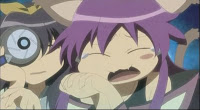 The other characters do their part as well, adding to the charm of the series as a whole. With the comedic elements that are profuse throughout the series, the combined whole turns what initially seemed like nothing special into a real treat. With Gonzo in charge of the animation, the space battles are nice to look at (though the 3D graphics for that kinda jars with the normal 2D computer graphics everywhere else) and things are visually appealing except for episode 2, where is seems that some other company took charge of things (the character designs
The other characters do their part as well, adding to the charm of the series as a whole. With the comedic elements that are profuse throughout the series, the combined whole turns what initially seemed like nothing special into a real treat. With Gonzo in charge of the animation, the space battles are nice to look at (though the 3D graphics for that kinda jars with the normal 2D computer graphics everywhere else) and things are visually appealing except for episode 2, where is seems that some other company took charge of things (the character designs  get ugly in that episode to the point of being a major distraction at times).
get ugly in that episode to the point of being a major distraction at times).
I hadn’t intended on being so wordy, but I guess that goes to show how much I really loved this anime. It holds a place of honor in my DVD collection and is certainly one of my top-10 favorite anime titles (along with its sequel).



 October 3rd, 2008
October 3rd, 2008  AstroNerdBoy
AstroNerdBoy  Posted in
Posted in  Tags:
Tags: 
Good call.
Too much retelling in the review though.
You’re absolutely right about that. The sad part is that the published version is pared down from what I had. ^_^; When I break out Vandread 2nd Stage, I’m going to really work on being better at not getting so caught up the retelling aspects.
Thanks for the comments. ^_^
I think you summarized what the series was about really well. You stated the strengths and weaknesses of the show.
I still wish they would expand just a little bit more on the series. I read another blog where a guy said that Hibiki was open with Dita and visa-versa, but Hibiki doesn’t seem to be as open with Dita as she is with him. Either way, Dita was open with him the whole series. Plus they stop the series leaving us hanging. How do we know if the plan to reunite men and women will work or not.
Tim — At some point, I need to watch Vandread: The Second Stage and I thought I’d comment on your concern there. I need to take some time to watch that now. ^_^;
[…] I poorly wrote an article on Vandread in October of 2008 for anyone interested. […]